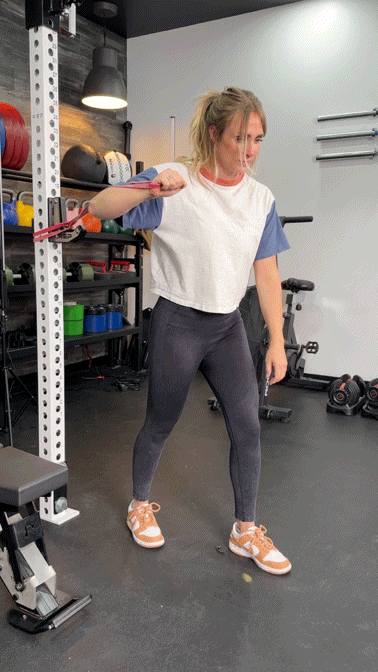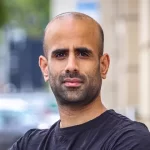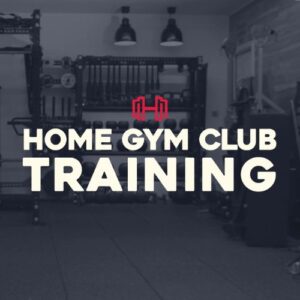When you think about training, you’re probably thinking the same things I did when I started. A big chest, legs, back, shoulders, and arms. The serratus anterior isn’t the first thing that people think of when it comes to muscle groups to exercise. And rightly so given that it’s fairly small and doesn’t get much hype amongst lifters.
However, that doesn’t mean that the serratus anterior isn’t important. It is. It helps to stabilize the shoulder muscles and assists with overhead movements such as the overhead press and dumbbell bench press. If you have a low enough body fat, a strong serratus anterior looks good, too.
Through performing serratus anterior exercises, you may prevent shoulder injuries, build strength, and improve scapular stability.
Medical disclaimer: This article is intended for educational and informational purposes only. It is not intended as a substitute for medical advice. For health advice, contact a licensed healthcare provider.
What Is the Serratus Anterior?
The serratus anterior, also known as the boxer’s muscle, is a fan-shaped muscle that originates at the first 9 ribs and inserts onto the medial border of the scapula (shoulder blade)1. The main part lies deep underneath the scapula and pectoral muscles. There are three parts:
- The serratus anterior superior, responsible for protraction
- The serratus anterior intermediate, which mainly protracts
- The serratus anterior inferior, which creates upward rotation
There are three main functions of the serratus anterior, according to Mike Masi, doctor of physical therapy. “The first is to protract the shoulder as seen when throwing a punch or reaching out in front of the body,” he says. “Secondly, it assists in elevating the arm by rotating the shoulder blade upward, as seen in an overhead press. Lastly, with a fixed shoulder the muscle will pull from the origin at the ribs and assist with inspiration.”

Benefits of Serratus Anterior Exercises
Now that you know what the serratus anterior is, you’re probably thinking, “But what are the benefits of strengthening it and why should I care?” There are a number of reasons:
- It can help with overhead mobility. You lift your arms up multiple times per day, even outside of exercising. Strengthening makes the upward rotation of the scapula much easier.
- You’re less likely to experience scapular dyskinesia. Dr. Masi says, “Scapular dyskinesia is a term describing aberrant motion of shoulder blade when moving the arm.”
- You’re less likely to get rotator cuff injuries. Rotator cuff injuries can be common, especially among those who train. Strong serratus anterior muscles may help to prevent these.
- It could help with other lifts. You use your core and shoulders in most lifts in the gym or at home. If you’ve never done serratus anterior exercises before, your weights could improve on certain exercises.
- It looks good (if you have a low enough body fat). Beyond all of the above, your serratus anterior can give you that shredded look just below the armpits if you train it often enough.

8 Best Serratus Anterior Exercises to Try
Now that you know what the serratus anterior is and the benefits of doing serratus anterior exercises, let’s take a deep dive into my eight favorite exercises:
Scapular Push-up
Why Do It: These can be done anywhere. Scapular push-ups strengthen the serratus anterior, but can also help to improve your core strength and posture. If you find bodybuilding exercises such as the overhead press challenging, scapular push-ups can be done as part of your warm-up.
How to Do It:
- Get into the regular push-up position with your hands slightly wider than shoulder-width apart.
- Engage your core by breathing in. At the same time, squeeze your glutes.
- Without moving your arms or elbows, retract your shoulder blades by squeezing your scapular muscles together. Then, round them downwards (you won’t move much as your arms and elbows aren’t moving).
- Unsqueeze the shoulder blades so that you’re back to the plank position, then repeat for the desired number of repetitions.

My tips: If you find that getting into a plank position to do scapular push-ups is too difficult, try using a wall or doing them on your knees instead. Once these become easier, you can switch to the regular version. Keep your feet close together and don’t bend your elbows. “Sometimes, I’ll cue athletes to embellish the scapular protraction at the top of the rep,” Dr. Masi says. “This encourages a little bit of thoracic flexion to allow the scapula more congruence with the thorax.”
Push-up
Why Do It: Although the push-up is known to be an exercise for the chest, deltoids, and triceps, it’s also a great exercise for activation of the serratus anterior. They’re extremely versatile, too, because of how many different types there are.
How to Do It:
- Start by getting into the plank position (only your hands and toes should be touching the ground).
- Position your hands so that they’re slightly wider than shoulder-width apart.
- Breathe in so that your core is engaged.
- Bending your elbows, lower your body with a straight back. Keep lowering until your chest is nearly touching the floor.
- Push yourself back up to the starting position, then repeat.

My tips: You can do these against a wall or on your knees if you find this easier. If regular push-ups become easy, try doing some incline push-ups, adding a weight plate on your back for more resistance, or even playing around with different hand positions. Either way, keep your back flat throughout.
RELATED: What Muscles Does the Push-Up Work?
Push-up Plus
Why Do It: The push-up plus can increase muscle power in the serratus anterior and reduce pain2. A weak serratus anterior can cause shoulder pain, and the push-up plus can assist to prevent this. You get all of the benefits of a regular push-up but with added extras.
How to Do It:
- Start by doing a regular push-up as described above.
- At the top of the movement (when your arms are straight), pause for a second.
- Then, by pushing away from the floor, lift the upper back until your scapula is undergoing protraction around the rib cage. Your shoulders will be slightly rounded here.
- Go back to the plank position and continue for reps.

My tips: Your elbows should stay straight during the plus movement (of course, you’ll need your elbows to bend for the regular push-up). The thoracic spine should be flat at all times. Start on your knees if you need to. If you can’t do the push-up plus, do the plus movement without the regular push-up and build up to the full exercise.
Unilateral Banded Chest Press
Why Do It: Because you’re doing one side at a time, the unilateral banded chest press is ideal to fix muscle imbalances. You get a long range of motion for serious serratus anterior activation, and you can increase the resistance by stepping further away from the anchor. And of course, you work your chest and triceps at the same time.
How to Do It:
- Using a resistance band with a handle, anchor it so that it’s at shoulder height.
- Facing away from the anchor, hold the handle with your right hand. Then, take a step or two forward.
- With your hand at the side of your chest and your chest up, press the band forward until your arm is straight. Pause here.
- Then, slowly return the band to its original position.
- Keep going then do the same with your left hand.

My tips: When you step forward, stand with one foot in front of the other to create a beter base of support. Don’t look up or down whilst pressing, but keep your head neutral.
RELATED: The Best Resistance Bands
Serratus Wall Slides
Why Do It: If you’re unable to do intense activities or get down on the floor, wall slides may be a good choice. “Wall slides can help to reduce the pain that often comes with shoulder impingement,” Dr. Masi says. “Shoulder impingement usually occurs because of repeated use and is often seen in swimmers, throwers, and other overhead athletes.”
How to Do It:
- Face a wall about a foot away.
- Bend your arms and put them on the wall, with the elbow located a few inches above your shoulder.
- With your palms facing each other, slowly slide your elbows down the wall until the are below your shoulder.
- While sliding, keep all movement in the shoulder, not allowing a “pull” to come from the pecs.
- Repeat.

My tips: If you find that your upper or lower back is moving at the high or low end of the movement, reduce the range of motion of your arms (don’t extend them fully upward).
Dumbbell Pullover
Why Do It: Not only does this work the serratus anterior, but it also works the chest, back, triceps, and core. Because you’re using a dumbbell for this one and not only your bodyweight, you can progress to your heart’s content. It also helps with overhead shoulder mobility.
How to Do It:
- With one dumbbell in both hands, lie down on a flat bench (similar to a dumbbell bench press but with only one dumbbell). Your feet should be flat on the floor.
- Extend the dumbbell above your chest so that your arms are straight.
- Now, with a slight bend in the arms, lower the dumbbell behind your head until you feel a stretch in your pecs and lats. Your core should be engaged at all times.
- Bring the dumbbell back to the starting position above your chest.
- Continue for the desired number of repetitions.

My tips: Some people prefer doing the dumbbell pullover by laying across a bench rather than flat on the bench. I don’t like this because it doesn’t feel as stable, but you can try it if you’d like. A slight arch in your lower back, similar to when you’re doing a bench press, usually helps. Don’t force the range of motion when you’re lowering the dumbbell behind your head (there’s no need!).
Ab Rollout
Why Do It: It’s one of best ab exercises, and one of the toughest on this list, but that’s a good thing. It helps to improve strength in the core muscles, including the serratus anterior. Consistent ab rollouts could lead to a better posture. Because lower body exercises such as deadlifts and squats require a strong core, you may get better at doing these too. Win-win!
How to Do It:
- Get onto your knees and take hold of an ab wheel.
- Engage your core, then let the ab roller roll out as far as possible. It’s important that your back is straight throughout.
- Pause for a second, then reverse the motion by rolling to the original position.
- Repeat.

My tips: If you or your gym doesn’t have an ab roller, you can use a barbell instead. This way, you can try different grip widths to see what works best for you. Don’t roll out as much if you find that your lower back starts to arch too much. And finally, control the movement (the slower, the better!).
RELATED: The Best Ab Rollers
Dumbbell Rotational Punch
Why Do It: Due to the external rotation of the hips and the shoulder movement involved with this exercise, you’ll strengthen your serratus anterior, core, and upper back. I like it because it increases your heart rate at the same time.
How to Do It:
- Whilst standing, take hold of a pair of light dumbbells. Your feet should be slightly wider than shoulder-width apart.
- With your palms facing each other, place the dumbbells around your core region.
- Using your hips, move your body to the left. Use your right foot to pivot here.
- At the same time, with your right hand, throw a punch with the dumbbell still in your hand.
- Return to the middle, and do the same thing but with your left hand.
- Punch for reps.

My tips: Lower the weight of the dumbbells (or don’t use any at all) if you’re finding it too hard; increase the weight if you’re finding it too easy. Make sure that you rotate at the hips and not your lower back as the latter might cause back pain.
Serratus Anterior Exercises: Final Thoughts
Although it’s not the most well-known muscle group in the human body, there are tons of benefits to strengthening the serratus anterior. If done properly, you may increase your lifts, improve the health of your shoulders, and prevent certain injuries from occurring.
To review, here are my eight favorite serratus anterior exercises for you to try:
- Scapular Push-up
- Push-up
- Push-up Plus
- Unilateral Banded Chest Press
- Wall Slides
- Dumbbell Pullover
- Ab Rollout
- Dumbbell Rotational Punch
Serratus Anterior Exercises: Q&A
Where is the serratus anterior muscle located?
The serratus anterior muscle begins at the far inside border of the shoulder blade, travels between the shoulder blade and the thorax, and attaches to the first nine ribs along the side of the body as they begin to wrap around to be seen from the front.
Which exercises work the serratus anterior?
If you’re looking to work the serratus anterior, you can try the following exercises: scapular push-up, regular push-up, push-up plus, bear hug, unilateral banded chest press, wall slide, dumbbell pullover, ab roller workouts, bear crawl, and dumbbell rotational punch. For best results, try different exercises to see what feels good for you, and do them consistently over a period of time.
Do push-ups train the serratus anterior?
Yes, bodyweight push-ups train various muscle groups in the upper body, including the serratus anterior. If you find that regular push-ups are too difficult (perhaps because you have scapular winging), you could try some scapular push-ups. These can be great for shoulder health and mobility. The push-up plus is another great exercise to train the serratus anterior.
What are the benefits of a strong serratus anterior?
Having a strong serratus anterior can help to prevent scapular dyskinesia, and rotator cuff injuries, which can be found in people who exercise often. Furthermore, you may find that certain lifts, but especially lifts that involve pressing a weight, improve. If you have a low enough body fat, you’ll reap the aesthetic benefits of strong serratus anterior muscles, too!
References
- Lung K, St Lucia K, Lui F. Anatomy, Thorax, Serratus Anterior Muscles. [Updated 2022 Sep 26]. In: StatPearls [Internet]. Treasure Island (FL): StatPearls Publishing; 2023 Jan-. Available from: https://www.ncbi.nlm.nih.gov/books/NBK531457/
- Yoo WG. Effect of the push-up plus guide and resistance device (PPGRD) on the serratus anterior during push-up plus. J Phys Ther Sci. 2016 Nov;28(11):3241-3242. doi: 10.1589/jpts.28.3241. Epub 2016 Nov 29. PMID: 27942157; PMCID: PMC5140837.








